* (restored)
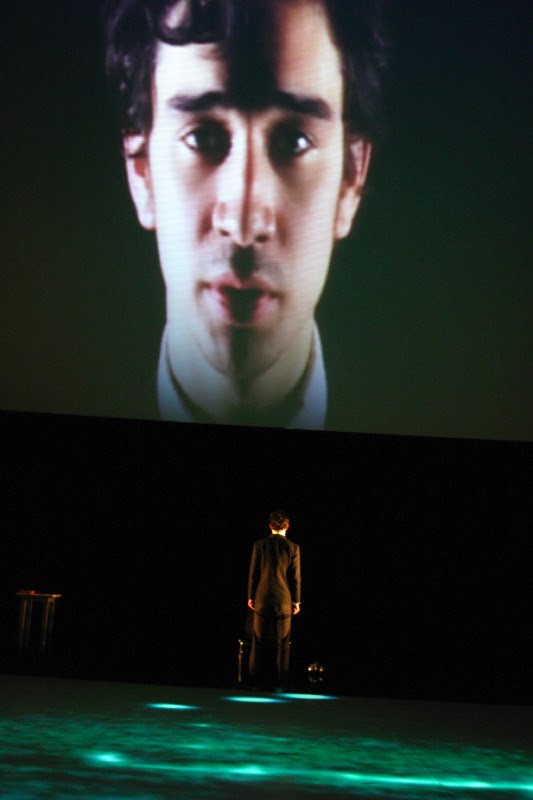
‘You live in this house. You walk in this street. If you’re going to be in a big space then you have to make it further. Which is interesting to me from the sculptural point of view—to always deal with the space that you’re in. That’s where you are. That’s where everybody else is going to be. So let’s not pretend that we’re someplace else.’ — John Jesurun
‘Director and writer John Jesurun’s presentations integrate elements of language, film, architectural space and media. His exploded narratives cover a wide range of themes and explore the relation of form to content. They challenge the experience of verbal, visual and intangible perceptions. His work is distinguished by his integrated creation of the text, direction, set and media design.
‘Jesurun is adept at playing with the gaps between what we know and what we think we know, and all of the hazy possibilities surrounding the petty certainties to which we cling. He treats his actors like found objects, setting their vocal qualities and idiosyncratic deliveries against his language and allowing for a certain live mayhem to destabilize the finely calibrated text.
‘Jesurun has employed a number of devices heretofore known as cinematic: jump cuts, pans, visual and verbal double tracks, and editing crosscuts of time and place to create multiple time frames. Most dramatically, Jesurun creates the equivalents of camera angles and points-of-view by the positioning of his actors against planar surfaces so that, to the audience, the actors appear overhead, below, or simply hanging in space.
‘Verbal characteristics of Jesurun pieces include verbal double exposures, dislocations via ellipses and non-sequiturs, sheer babble, and the taking of song lyrics (circa 1967-69) such as Hendrix’ “I’m a voodoo chile” to their illogical conclusions.
‘He began presenting theater works in 1982 at the Pyramid Club with his groundbreaking serial play Chang in a Void Moon, now in its 60th episode (“Bessie” Award). Since 1984 he has written, directed and designed over 25 pieces including: the media trilogy of Deep Sleep (1986 Obie), White Water and Black Maria, Number Minus One, Red House, Shatterhand Massacree, Everything That Rises Must Converge, Slight Return, Faust/How I Rose, Septet and Snow.’ — collaged
____
Shots
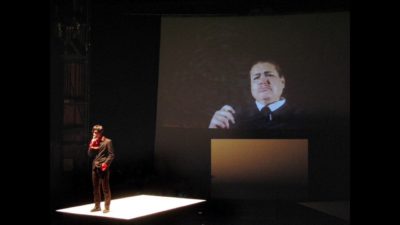


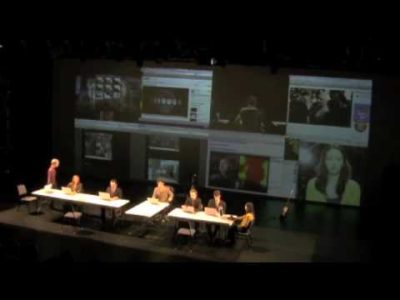




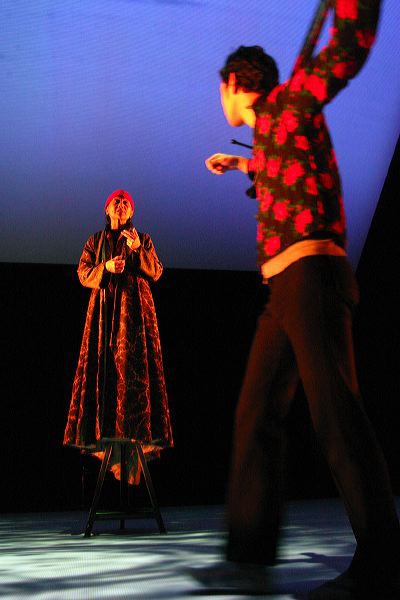
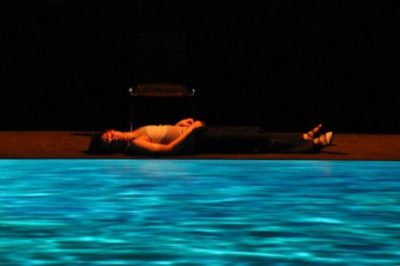
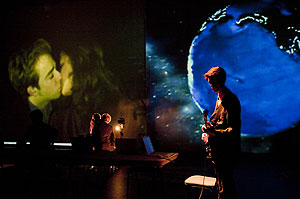

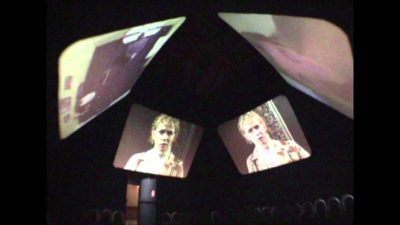
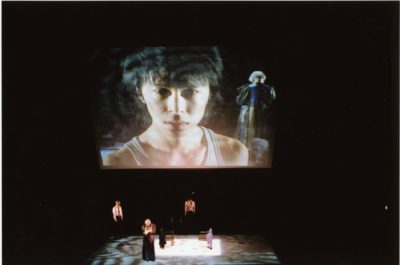

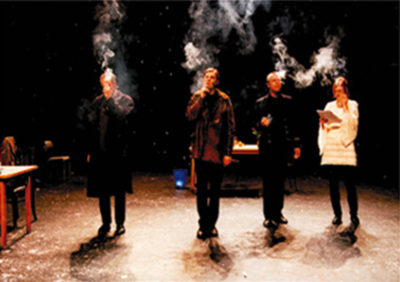
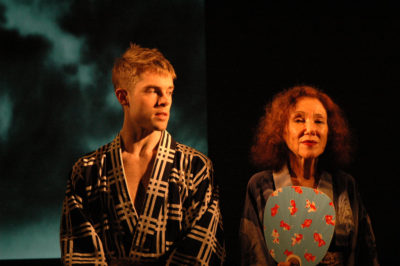

_____
Further
John Jesurun Official Website
John Jesurun interviewed @ Bomb Magazine
Audio: John Jesurun’s ‘Duet’
John Jesurun’s Vimeo Channel
‘Language Makes Itself Come True: An Introduction to John Jesurun‘
‘Performance as Design: John Jesurun’s Mediaturgy’
Book: John Jesurun’s ‘A Media Trilogy’
John Jesurun Page @ Facebook
John Jesurun @ goodreads
____
Extras
Jesurun directed music video for Jeff Buckley’s ‘Last Goodbye’
Jesurun directed music video for Barbez’s ‘Black Forest’
John Jesurun narrates a historical retrospective of his work
__________________________________
breaking the relentless spool of film unrolling
by John Jesurun
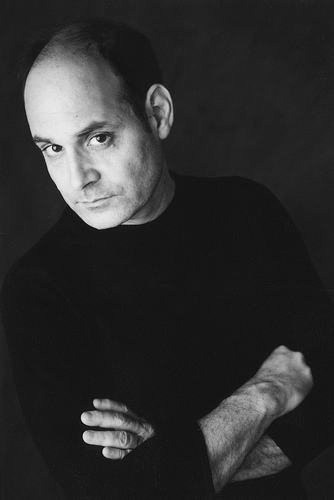
The innocent eye is essentially the pinhole through which one perceives. What the eye focuses on has as much to do with physical as well as mental processes occurring on both sides of it. Both sides are in a constant and sometimes hostile state of educative communication. They are positioned in a line of communication that extends itself within a chain of command struggling to find meaning in itself. The human struggle to get from the inside to the outside and bring the outside to the inside is full of detours, pitfalls and discoveries in interpretation. There is a constant search for the correct translation.
Our original mediators, language, sound, vision, smell, touch, have been compounded by the addition of other mediators in the form of cameras, imitations, reproductions, recordings. In an almost organic way these mediators reproduce themselves at an astonishing speed. As we have discovered new mediators in an effort to understand ourselves, it has made things clearer and more confusing at the same time. The sophisticated and sometimes brutal techniques in which we present and filter information in our ordinary, contemporary reality is certainly an influence on my work.
One of the main concerns in my work is the use of spoken language and its structure. The many levels and layers through which a thought struggles to become words and language constantly reinvigorate communication. Also important to me is the relationship of content to sound and rhythm and how these reflect the impulses of thought and emotion.
In a sense the use of media is one step further away from the brain than the spoken word. But in other ways it seems one step closer because we are capable of making it dissect the very language that set it into motion. It sees and remembers more than our physiology allows our sanity. We can even attempt to catch it and return to its natural internal origins. It is a reflection of the sophisticated techniques our minds use to decipher, edit, reconstruct, contrive and adapt our personal and collective realities. These techniques are primal, (automatic?). We are constantly looking for their origins.
______________________
13 of John Jesurun’s works
_______________
Chang in a Void Moon (1982 -> )
‘John Jesurun’s legendary “living film serial”, Chang in a Void Moon,the first serialized play ever produced in NY, began in 1982 at the Pyramid Club with Episode #1, won a Bessie in 1985, and has been highly acclaimed through over 58 episodes produced to-date in New york, Munich, Zurich and Berlin.
‘Chang in a Void Moon laid the groundwork for a style distinguished by integrated creation of text, direction, set and media design. Chang is influenced more by film, television and radio than by theatrical convention. Scenes begin and end abruptly, as if cut and spliced together. Actors are suspended on platforms in various configurations to replicate overhead shots and shots from below. Sailboat races, car crashes and chases, levitating objects-even a decapitation-have all been staged with astonishing aplomb and a decidedly cinematic manner. A captivating intermingling of both contemporary American pop culture and world history, Chang is at once ironic yet oddly sincere. Michael Feingold said of the work, “Chang is an unremitting stream of violent acts offstage and violent verbal assaults on. They’re made light instead of lugubrious by their fantasticated quality, which encourages us simultaneously to fear the infinite power of Chang’s rich, unscrupulous characters, and to laugh at them as part of an outrageous cosmic joke.” The characters of the serial mysteriously exist in a nether region where time is non-linear, events and circumstances erupt without context, and geographic boundaries are meaningless. At times characters appear to live simultaneously in multiple time zones, across many centuries.
‘Don Shewey made the observation that “It’s really theater of language, the actors conjuring it all up with an earnest delivery that is often hilarious in its campy elevated diction. …there is a historical continuum that connects Jesurun’s writing backwards to Richard Foreman and Jim Strahs and forwards to Richard Maxwell.”
‘With Chang, Jesurun has consistently worked with some of New York’s most exciting performers. Over the years his company has featured: Steve Buscemi, Ethyl Eichelberger, Greg Mehrten,John Kelly, Edoardo Ballerini, Tom Murrin, Anna Kohler, Darren Pettie, Black-Eyed Susan, Ching Valdes-Aran, Mark Boone-Junior, David Cale, Frank Maya and the choreographer Neil Greenberg, among others. Many of these performers first came to prominence with their work in Chang, and most of them continue to appear in new episodes.’ — Broadway World


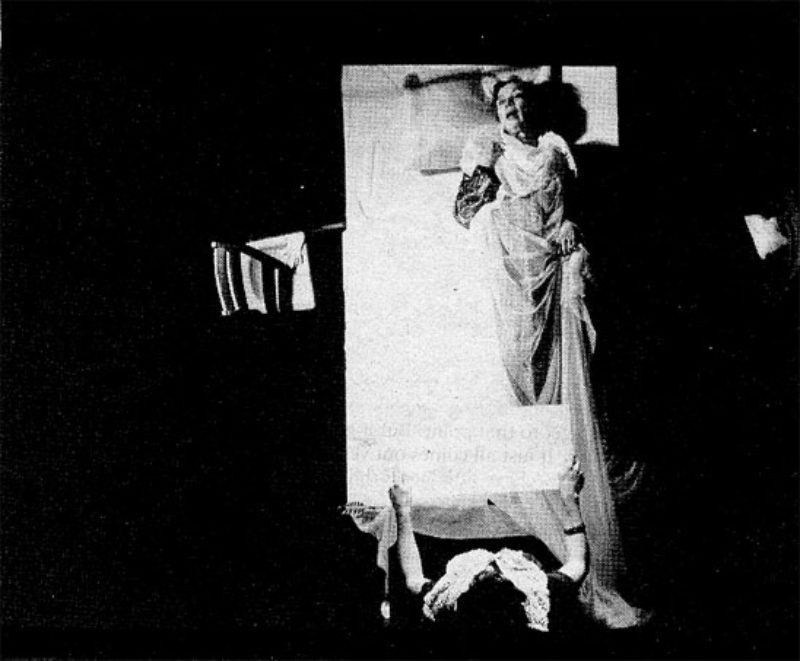
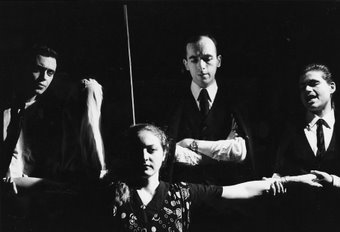
_________________
Shatterhand Massacree (1985)
‘John Jesurun (playwright, director, media artist) began began his theatrical career in 1982 at the Pyramid Club on the Lower East Side with his groundbreaking serial play Chang in a Void Moon, now in its 60th episode.Since then has been a pioneering force in the use of film and video in live performance. His early interest in issues of identity, presence, and communication have been extended over the years to the digital age. As a writer, director, and designer, he has created unique forms of narrative that capture the dislocation and anxiety of contemporary life in real, virtual, and performance spaces. His many works have been performed all over the world, and range from storytelling to classics to computer-based theatre, including Deep Sleep, Shatterhand Massacree, Firefall and Philoktetes.’ — La Mama
Excerpt
Excerpt
_________
Black Maria (1987)
‘Entering La Mama Annex, rearranged to accommodate John Jesurun’s Black Maria, one immediately wonders where the stage is. The seats are facing in all directions and fill the floor space. The fact is there is no stage. With Black Maria, Mr. Jesurun has moved a step beyond Deep Sleep and White Water, the previous plays in his theater-movies-television cycle. This time, the audience is surrounded by movie screens, four of them as walls and one as ceiling. There are no live actors; the ”play” is entirely on film. Soon the screens are overflowing with vivid images – of actors and landscapes, both interior and exterior. As in the earlier plays, the actors speak to one another across the heads of theatergoers. We are thrown into the middle of a mystery, a threatening story that has something to do with a lonely house in the country, a leper colony, an escaped convict and a missing, perhaps dead horse. As a theater artist, Mr. Jesurun forms a graphic composition, and it stands, enigmatically, by itself. We have no idea what his next move will be.’ — NYT
Excerpt
__________________________
Everything that Rises Must Converge (1990)
‘Jesurun’s performances of Everything That Rises Must Converge eviscerate the nervous system. The performance is a control system that lays bare the innerworkings of language and consciousness. This piece was first performed at the Walker Arts Center in Minneapolis and the at the Kitchen in New York in 1990. Mel Gussow, writing in the New York Times, obseved that the language of the play was complex, moving “backwards, forward and sideways”, but “what holds the audience’s attention is the ingenious style of presentation. While we are still trying to correlate the barrage of words and the live video figures, some of whom appear to be taking to themselves, the rear wall suddenly swings to a perpendicualar, revealing an entirely different audience siting on bleachers on the opposites side of the stage. In a mirror reversal, they have been watching our actors on monitors and our monitor-actors on stage.’ — Sun & Moon
Excerpt
_________
Slight Return (1994)
‘John Jesurun’s Slight Return was originally presented at the Randolph St. Gallery in Chicago and La Mama. In this piece the actor is not physically visible by the audience. He is enclosed in a 2 meter by two meter room which sits on the stage. His performance is fed live to five video projection screens. It is more of a live experience than an experienced illusion. Its feelings live in the crack between the deeply located inner voice and the outer world of human communicative experience. The production with its hidden actor and shifting bank of video images has an immaculate stillness suggesting a world of removed but constant observation. The actor explains in an unbroken sometimes delirious monologue that the surrounding city has been leveled and all the government leaders are gone. He appears to be the only survivor, along with a cat, inside a collapsed hotel. His journey unfolds over a hundred floors in an underground world which resembles the interior of a volcano and where direction has no meaning.’ — John Jesurun Site
Excerpt
________________
Imperial Motel (Faust) (1996)
‘IMPERIAL MOTEL (Faust) is a cross-media performance which encompasses several versions of “Faust”, including a new version written for the company by John Jesurun, as well as many past versions. Set in a motel room surrounded by cameras, the performance revolves around a latter-day American Faust, “wrestling with his demons” in an anonymous, modern space, and a more nostalgic German Faust, recreating and recording older versions of the parable. Through this “live film,” the two Fausts encountered a variety of characterizations of Gretchen, Wagner, and other stock characters.’ — The Builders Association
Excerpt
_______________
Chang in a Void Moon, episodes #51-53 (1997)
Excerpt 1
Excerpt 2
_____
SNOW (2000)
‘Like some of his previous multi-media explorations, Jesurun’s Snow has a plot, characters and dialogue but an unorthodox relationship to its spectators. Audience members are seated in a square, walled-off room at the center of a larger performance space designed by Jesurun and scenic collaborator Sally Fredkin. Meanwhile, the cast of Snow (four human beings, and a mobile robotic camera supplemented with a human voice) perform their roles out of immediate sight but close at hand, in a nearby hallway and in adjacent cubicles. Their actions are captured live on video cameras and relayed to the audience via four overhead screens. Since Jesurun’s fable about media run amok in a remote-control world is set in a TV studio, “Snow” is both a deconstruction of media voyeurism and an experience of it. We look on, from up close yet at a remove, as the aging TV movie star Cricket (Valerie Charles) learns she’s a high-tech pawn of the information age and a victim of cyber- stalking.’ — The Seattle Times
Excerpt
_____
Septet (2005)
‘Being in the calibration department for three years since I was 17 has been ….it’ll be hard to leave the calibration department when the purgatorium is finally enacted. We are caught up in deciphering so many meanings behind meanings behind meanings. Did you ever hear about that group, the Beatles? There apparently was a walrus in one of their songs and no one could figure out the meaning of it. Finally the band member Paul admitted he was the walrus. I’’ll have to see if I can get that song and listen to it sometime and find out what it meant. In any case I am not the walrus in this story. Anyway, I….. How do you like your job? That first paycheck is a real rush.’ — Text from ‘Septet’
Excerpt
Excerpt
___________
PHILOKTETES (2005)
‘It’s worth letting the experience of Philoktetes sink in for a while before trying to dissect it — writer-director-designer John Jesurun’s abstract new work takes its name and part of its structure from Sophocles’ drama, but its emotional texture is unique and deserving of some rumination. By turns a meditation on the Greek play, an antiwar jeremiad and an infuriating snarl of almost-penetrable symbolism, Jesurun’s 70 minutes of blank verse are beautifully staged and acted, particularly by lead Louis Cancelmi, though they eventually wander off, aided in their escape by the production’s dim lighting.’ — Variety
Excerpt
Excerpt
_____
Firefall (2009)
‘FIREFALL exists in several linked dimensions: a central governing website, live performance, altered video stream. In this environment, the cast attempts to maintain a script that keeps breaking down. As seven performers access and contribute live web interventions, the constantly evolving site becomes a character in itself. Multi-tasking “drama” unfolds as the performers and technicians struggle against being consumed by the expanding form they are creating. “Jesurun’s obsession with seeing….and his method of masterminding the audience’s field of vision are the essential keys to the quiet hysteria his work generates.” – Artforum International’ — Dance Theater Workshop
Excerpt
______
LIZ ONE (2009)
‘Black-Eyed Susan plays Elizabeth I of England as revealed through her private diaries. She struggles with a revolving set of presences to disentangle, un-write and finally rewrite her own biography. These intensely reflected histories include her perceptions regarding her five estranged children, their fathers, her own father, her hidden relationship with Buddhism and finally her disastrous attempt to invade North Africa. She inter-reacts with the kaleidoscopic array of ideas and characters through Jesurun’s multi-dimensional use of language and technology. Jesurun and Black-Eyed Susan are long time collaborators having first worked together in Jesurun’s 1984 production of Red House.’ — The Chocolate Factory
Excerpt
___________________
Stopped Bridge of Dreams (2012)
‘John Jesurun’s Stopped Bridge of Dreams unfolds inside an anonymous globe circling jetliner—a modern age pleasure palace—operated by a mother and son.Inspired by 17th Century Japanese writer, Saikaku Ihara’s “‘floating world” stories, Stopped Bridge of Dreams features a variable nightly series of revolving playlets and characters. Jesurun weaves text, video, music and live internet feeds to reflect the anxiety of spiritual and sexual dislocation in contemporary life. Featuring Obie-winning actress Black-Eyed Susan.’ — La Mama
Trailer 1
Trailer 2
Trailer 3
______________
Chang in a Void Moon, episodes #59-61 (2014)
Trailer
Excerpts
Excerpt (Episode #61)
________________
Fragments From a Triumphal Arch (The Palace at 3am) (2014)
‘With this New York-based artist’s main theme of exploring the rampant technologization of contemporary culture and its effects on consciousness and communication alike, Jesurun’s work challenges one-dimensional interpretations while simultaneously underscoring the processes that constitute our perception. His incessant interplay with various media thereby strikes as the most obvious strategy, with the texts’ pervasive multilingualism a close second, all while generating a sense of mediatised imbrication of the performative event’s combined constituents.’ — Christophe Collard
Performance Timelapse version
—-
*
p.s. Hey. ** David Ehrenstein, Hm, interesting re: Gaddis’s camp along the edges. Next time I reread him, I’ll use that radar. Interesting too that you liked ‘Seberg’. I think you’re the first person that hasn’t dissuaded me from it. Okey-doke. ** richard, Hi! Oh, wait, are you Richard as in Labonte? If so, warmest hugs and very happy to see you! If not, my apologies for the presumption, and it’s very nice to meet you. Win-win. ** Steve Erickson, Hi. Well, maybe being the NYT, they’re already seen everything being released before year’s end? I don’t know why I’m trying to give them the benefit of the doubt though. Very, very curious to see that Merce Cunningham 3D doc. Interesting. Well, it’s not like everyone who knows who he is doesn’t already know he was gay. It’s not like it isn’t a given. And I’m pretty sure there are books and definitely writings online that go into his relationships with Cage and Rauschenberg. I seem to be in a ‘benefit of the doubt’ mood today for some reason, ha ha. I hope the Quietus gives you a big yes, obviously. ** _Black_Acrylic, Nice painting. Is it of anyone in particular? I’ll skip ‘The Report’, thanks. Does not look like my kind of thing. ** sleepyj, Hi. Thank you about the post. Oh, you know Bill Jones? Excellent. He’s an old friend of mine although I haven’t seen him in ages. Ah, Xmas lights in the palm trees. That takes me back, being an LA born and raised guy. I’d happily shuttle a fair amount of our nearly nonstop rain to you and yours if I were a deity. I have to say I like Xmas decorations a whole bunch. And that may be partly a nostalgia thing even though I consider nostalgia one of the great enemies. But I do. Do you? Sounds like it. And Paris does Xmas decorations like wild fire, or else it’s a city beautiful enough that the overlay just enhances what one sees daily to the max. You ever been here? I recommend a jaunt. Happy day! ** Bill, Hi, B-ster. The new Swans feedback I’ve heard seems to circle around the idea that it sounds kind of tired or a bit too ‘what one would expect’. I think that’s the gist of what I’ve heard? But I need to find out for myself, duh. We all know these days how hearsay can be a mental laziness generator. I have not seen ‘November’. I’ve heard of it. Hm, it does look tempting. ‘Bonkers bizarro monochromatic folk horror’: sounds like it might the true face of be what ‘The Lighthouse’ tried so crappily to be. Folk Horror is such a thing right now. Interesting. Thanks for the tip, Bill! ** Okay. If you don’t live in or around NYC or maybe Brussels, it’s pretty likely that you don’t know the works of John Jesserun first hand, which is a shame in my book as he’s one of my very favorite makers of theater, a singular and brilliant/brainy auteur of the form. So today I thought I would bring back my old, dead JJ post, newly updated and enhanced a bit, so you can at least know his work exists and dig into some representations if you so choose. See you tomorrow.




 Now available in North America
Now available in North America 
Jesurun’s work is remindful of aspects of Michael Snow, Richard Foreman and Yvonne Rainer.
Cunningham’s gayness, like Cage’s and Rauschenberg’s was “The Great Unspoken” to that generation of gay artists. It’s why Rauschnberg and Johns kept their distance from Andy — who couldn’t act “Butch” save his life. The Cunningham’s, as the doc shows, is fascinating but markedly un-homoerotic.
I often wish there could be more of a theatre scene here in Dundee. Sure we have the Rep and it does a valuable job but still, there’s not any Jesserun equivalent, that’s for sure .
That 90s porn painting subject? One art school lunchtime I bought a random second hand porn magazine from Leeds market. Now that I think about it, there is something slightly strange about that haha.
I assume that Cunningham started talking about his gayness by the end of his life, considering that he died at 90 in 2009, but there’s a weirdly old-fashioned quality to the documentary’s avoidance of the subject. I like the fact that it avoids bio/doc cliches like telling Cunningham’s life story from birth to death through interviews, but the only subject not 100% related to Cunningham’s dances that it brings up is his power over his dancers (and it doesn’t cut that deeply.) But the best parts of the film are the 14 dance pieces it stages, which make up two thirds of it. Anyway, I’m thinking up questions for the director, and I’ve been pondering this.
I wish a happy Thanksgiving tomorrow to anyone who celebrates it.
Hey. I do love decorations; lights, snow, wreaths, garland, bells, all of it. Especially an overlay. And I agree that nostalgia is a tricky one. I have been to Paris, a long time ago. I would definitely go back. Talk soon 🙂